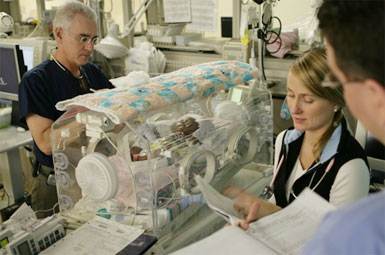The AHA has produced a comprehensive guideline on venous thromboembolic disease. Here are some excerpts pertaining to resuscitation room decision making, particularly: ‘should I thrombolyse this patient?’

Definition for massive PE: Acute PE with sustained hypotension (systolic blood pressure <90 mm Hg for at least 15 minutes or requiring inotropic support, not due to a cause other than PE, such as arrhythmia, hypovolemia, sepsis, or left ventricular [LV] dysfunction), pulselessness, or persistent profound bradycardia (heart rate <40 bpm with signs or symptoms of shock).
Definition for submassive PE: Acute PE without systemic hypotension (systolic blood pressure ≥90 mm Hg) but with either RV dysfunction or myocardial necrosis.
RV dysfunction means the presence of at least 1 of the following:
- RV dilation (apical 4-chamber RV diameter divided by LV diameter >0.9) or RV systolic dysfunction on echocardiography
- RV dilation (4-chamber RV diameter divided by LV diameter >0.9) on CT
- Elevation of BNP (>90 pg/mL)
- Elevation of N-terminal pro-BNP (>500 pg/mL); or
- Electrocardiographic changes (new complete or incomplete right bundle-branch block, anteroseptal ST elevation or depression, or anteroseptal T-wave inversion)
Myocardial necrosis is defined as either of the following:
- Elevation of troponin I (>0.4 ng/mL) or
Elevation of troponin T (>0.1 ng/mL)
Odds ratio for short-term mortality for RV dysfunction on echocardiography = 2.53 (95% CI 1.17 to 5.50).
Troponin elevations had an odds ratio for mortality of 5.90 (95% CI 2.68 to 12.95).
Definition for low risk PE: those with normal RV function and no elevations in biomarkers with short-term mortality rates approaching ≈ 1%
Recommendations for Initial Anticoagulation for Acute PE
- Therapeutic anticoagulation with subcutaneous LMWH, intravenous or subcutaneous UFH with monitoring, unmonitored weight-based subcutaneous UFH, or subcutaneous fondaparinux should be given to patients with objectively confirmed PE and no contraindications to anticoagulation (Class I; Level of Evidence A).
- Therapeutic anticoagulation during the diagnostic workup should be given to patients with intermediate or high clinical probability of PE and no contraindications to anticoagulation (Class I; Level of Evidence C).
Patients treated with a fibrinolytic agent have faster restoration of lung perfusion. At 24 hours, patients treated with heparin have no substantial improvement in pulmonary blood flow, whereas patients treated with adjunctive fibrinolysis manifest a 30% to 35% reduction in total perfusion defect. However, by 7 days, blood flow improves similarly (≈65% to 70% reduction in total defect).
Thirteen placebo-controlled randomized trials of fibrinolysis for acute PE have been published, but only a subset evaluated massive PE specifically.
When Wan et al restricted their analysis to those trials with massive PE, they identified a significant reduction in recurrent PE or death from 19.0% with heparin alone to 9.4% with fibrinolysis (odds ratio 0.45, 95% CI 0.22 to 0.90).
Data from registries indicate that the short-term mortality rate directly attributable to submassive PE treated with heparin anticoagulation is probably < 3.0%. The implication is that even if adjunctive fibrinolytic therapy has extremely high efficacy, for example, a 30% relative reduction in mortality, the effect size on mortality due to submassive PE is probably < 1%. Thus, secondary adverse outcomes such as persistent RV dysfunction, chronic thromboembolic pulmonary hypertension, and impaired quality of life represent appropriate surrogate goals of treatment.
Data suggest that compared with heparin alone, heparin plus fibrinolysis yields a significant favorable change in right ventricular systolic pressure and pulmonary arterial pressure incident between the time of diagnosis and follow-up. Patients with low-risk PE have an unfavorable risk-benefit ratio with fibrinolysis. Patients with PE that causes hypotension probably do benefit from fibrinolysis. Management of submassive PE crosses the zone of equipoise, requiring the clinician to use clinical judgment.
An algorithm is proposed:

Two criteria can be used to assist in determining whether a patient is more likely to benefit from fibrinolysis: (1) Evidence of present or developing circulatory or respiratory insufficiency; or (2) evidence of moderate to severe RV injury.
Evidence of circulatory failure includes any episode of hypotension or a persistent shock index (heart rate in beats per minute divided by systolic blood pressure in millimeters of mercury) >1
The definition of respiratory insufficiency may include hypoxemia, defined as a pulse oximetry reading < 95% when the patient is breathing room air and clinical judgment that the patient appears to be in respiratory distress. Alternatively, respiratory distress can be quantified by the numeric Borg score, which assesses the severity of dyspnea from 0 to 10 (0=no dyspnea and 10=sensation of choking to death).
Evidence of moderate to severe RV injury may be derived from Doppler echocardiography that demonstrates any degree of RV hypokinesis, McConnell’s sign (a distinct regional pattern of RV dysfunction with akinesis of the mid free wall but normal motion at the apex), interventricular septal shift or bowing, or an estimated RVSP > 40 mm Hg.
Biomarker evidence of moderate to severe RV injury includes major elevation of troponin measurement or brain natriuretic peptides.
Two trials are currently ongoing that aim to assess effect of thrombolysis on patients with submassive PE: PEITHO and TOPCOAT
Recommendations for Fibrinolysis for Acute PE
- Fibrinolysis is reasonable for patients with massive acute PE and acceptable risk of bleeding complications (Class IIa; Level of Evidence B).
- Fibrinolysis may be considered for patients with submassive acute PE judged to have clinical evidence of adverse prognosis (new hemodynamic instability, worsening respiratory insufficiency, severe RV dysfunction, or major myocardial necrosis) and low risk of bleeding complications (Class IIb; Level of Evidence C).
- Fibrinolysis is not recommended for patients with low-risk PE (Class III; Level of Evidence B) or submassive acute PE with minor RV dysfunction, minor myocardial necrosis, and no clinical worsening (Class III; Level of Evidence B).
- Fibrinolysis is not recommended for undifferentiated cardiac arrest (Class III; Level of Evidence B).
Recommendations for Catheter Embolectomy and Fragmentation
- Depending on local expertise, either catheter embolectomy and fragmentation or surgical embolectomy is reasonable for patients with massive PE and contraindications to fibrinolysis (Class IIa; Level of Evidence C).
- Catheter embolectomy and fragmentation or surgical embolectomy is reasonable for patients with massive PE who remain unstable after receiving fibrinolysis (Class IIa; Level of Evidence C).
- For patients with massive PE who cannot receive fibrinolysis or who remain unstable after fibrinolysis, it is reasonable to consider transfer to an institution experienced in either catheter embolectomy or surgical embolectomy if these procedures are not available locally and safe transfer can be achieved (Class IIa; Level of Evidence C).
- Either catheter embolectomy or surgical embolectomy may be considered for patients with submassive acute PE judged to have clinical evidence of adverse prognosis (new hemodynamic instability, worsening respiratory failure, severe RV dysfunction, or major myocardial necrosis) (Class IIb; Level of Evidence C).
- Catheter embolectomy and surgical thrombectomy are not recommended for patients with low-risk PE or submassive acute PE with minor RV dysfunction, minor myocardial necrosis, and no clinical worsening (Class III; Level of Evidence C).
Management of Massive and Submassive Pulmonary Embolism, Iliofemoral Deep Vein Thrombosis, and Chronic Thromboembolic Pulmonary Hypertension
Circulation. 2011 Apr 26;123(16):1788-1830 (Free Full Text)








